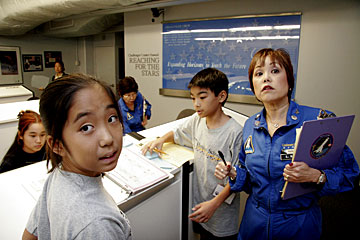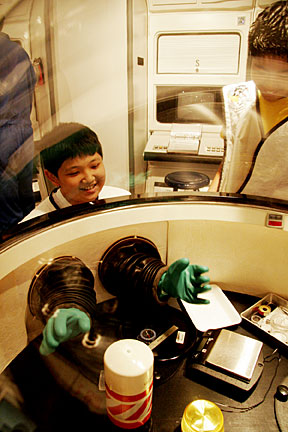CHALLENGER 20TH ANNIVERSARY

CRAIG T. KOJIMA / CKOJIMA@STARBULLETIN
At the Challenger Center Hawaii's space station at Barbers Point Elementary School, Shanece Gambol attached a sensor to the uniform of Noah Takaesu at the start of an exercise yesterday. The students are from Hanalani School.
|
|
The Legacy Lives
Thousands of schoolkids recognize Onizuka's contributions today
HILO » Twenty years ago this Saturday, when the Challenger space shuttle vanished into a horrifying ball of white against a brilliant blue sky, an image that seared itself into the memories of millions of Americans, it was difficult to imagine that any good would come from it.
With the death of Hawaii astronaut Ellison Onizuka and six of his colleagues, America's space program seemed for a while destined to die as well.
Yet in their deaths, something entirely different has happened. While painful memories linger among those adults who witnessed the explosion of the Challenger 73 seconds after takeoff on Jan. 28, 1986, their children have come away with an entirely different lesson from the tragedy. And it's not about quitting.

FILE PHOTO
The space shuttle Challenger explodes shortly after lifting off from Kennedy Space Center on Jan. 28, 1986.
|
|
That's especially true here on the Big Island, home to the Astronaut Ellison S. Onizuka Space Center at the Kona airport, where for visiting children Onizuka is not the victim of an accident, but a Hawaii native who succeeded in life and made success possible for others.
"Ellison was the first Asian American to be up in space," said Sai Weiss, an eighth-grader at Hilo Intermediate School who has read Onizuka's biography.
"He was proud to be one of the members (of the astronaut team) to be up in space," Weiss said. "He also opened a new door for other people in Hawaii. Now they knew there's not only people from the mainland, but people from the islands to be recognized."
His is not a lone voice among today's younger generations. Every student in school today was born after the disaster.

FILE PHOTO
All seven Challenger crew members were killed, including Hawaii-born Ellison Onizuka, above at left.
|
|
"He's ancient history to them," Donna Goodale, a teacher at Hualalai Academy in Kona, said about Onizuka.
Ancient, perhaps, but part of living history, too -- his memory kept alive at the Kona space center and other places in the state.
On the Big Island, students travel long distances to learn about him and the space program. In teacher Pascale Pinner's class at Hilo Intermediate, where Weiss is a student, half of his classmates have made the 200-mile round trip to the Kona center.
The students know Onizuka, who was born in Kealakekua, spent his childhood there.
"Ellison Onizuka used to sit in the coffee fields and look at the stars," wrote sixth-grader Nicole Nakakura at Innovations Public Charter School.
On Oahu, at the private, nonprofit Challenger Center Hawaii at Barbers Point Elementary School, 60,000 students in the sixth through eighth grades have performed astronaut "missions" since the center opened in 1993.

CRAIG T. KOJIMA / CKOJIMA@STARBULLETIN
Courtney Nakagawara and Evan Kawamura faced a battery of monitors and some emergency routines yesterday at "mission control" in the Challenger Center Hawaii at Barbers Point Elementary School. With them was mission coordinator Liane Kim, right.
|
|
Director Liane Kim said visitors are not limited to Honolulu. Neighbor island kids do fundraisers to pay for a trip there.
That so much attention is heaped on Onizuka is a source of pleasure for his widow.
"I am really glad that they know of him at all," Lorna Onizuka said from her office in Houston. "I look at it more like Columbus. They don't think about how he died. It might have been a horrible death, but we don't think about that."
But Columbus' death was not videotaped and shown to the entire world repeatedly.
Innovations Public Charter School teacher Jennifer Hiro was a Konawaena High senior in 1986. On the day of the Challenger disaster, a TV set in her classroom kept showing the explosion "over and over and over."
"I wanted them to stop playing it," she said. "The teachers were horrified."
The coming anniversary will be a poignant moment for Art Kimura. One year before the disaster, he was a selectee for the Teacher in Space position. That seat in the Challenger went to teacher Christa McAuliffe, who died in the explosion.
Now retired from the state Department of Education, Kimura recognizes that good came out of the tragedy.
"It changed my life. I would have gone into school administration," he said. Instead, in 1991 he created a space-oriented science program called Future Flight on the Big Island, which has since expanded throughout the state. The accident would lead to the creation of four major space programs in Hawaii.

CRAIG T. KOJIMA / CKOJIMA@STARBULLETIN
Noah Takaesu and Keoni Wharton worked on meteorite samples in the "glove box" yesterday at the Challenger Center Hawaii. All the students were from Hanalani School.
|
|
Besides Future Flight, they are the Onizuka Space Center in Kona, Space Grant Consortium activities at Windward Community College, headed by fellow 1985 Teacher in Space selectee Joseph Ciotti, and the Challenger Center Hawaii at Barbers Point.
Meanwhile, other programs on the Big Island taking place this week are Journey Through the Universe, intended to reach 7,000 students directly or indirectly, culminating with Ellison Onizuka Science Day at the University of Hawaii at Hilo from 8 a.m. to 3 p.m. Saturday. The guest speaker will be astronaut Robert Curbeam Jr. at 9:30 a.m.
Because of all these programs, and heightened awareness, when children mention the Challenger accident these days, there is a sense that it was not in vain.
For Brace Gotshalk, a fifth-grader at Haaheo Elementary in Hilo, it was not enough to know that the Challenger blew up. He insisted that his father explain the reason why: a gasket-like O-ring that failed, releasing hot gasses.
NASA learned from it, said eighth-grader Devin Chu in Pinner's class.
"Engineers now knew what would happen. It didn't totally destroy the whole thing of space travel. It improved it," he said.

ELLISON ONIZUKA
Born: June 24, 1946, Kealakekua, Hawaii
Graduated: Konawaena High School, 1964
Masters degree: Aerospace engineering, University of Colorado, 1969
Service: U.S. Air Force, 1970-1986
Astronaut: 1978-86
First mission: Discovery, Jan. 24-27, 1985
Final mission: Challenger, Jan. 28, 1986
Source: NASA
|
|
Rites also planned in Texas and Florida
Star-Bulletin staff
Ellison Onizuka's daughter Darien, 30, will attend a Remembrance Day on Saturday at a memorial grove of oak trees on the grounds of the Johnson Space Center in Houston, her mother, Lorna, said.
Each fallen astronaut has a tree, each with a plaque, Lorna Onizuka said yesterday by telephone.
"It's the nearest thing when we can't be at Punchbowl (where Ellison is buried)," she said.
Although the Johnson center is the site of Mission Control, the grove also has a surprising mix of deer and rabbits, she said.
Onizuka's older daughter, Janelle, 35, feeling a bit sick, will not attend. Onizuka herself will fly today to Kennedy Space Center in Florida for a reunion of Challenger astronauts' spouses.
Onizuka said she tells her girls, "Yes, you will have some memories you prefer not to think about, but (the anniversary on) the 28th will be like the 27th and the 29th. You think about Dad every day."
"He was a fortunate man because he left good things behind," she said.
Onizuka continues her job with the Japan Aerospace Exploration Agency in Houston. Janelle, married with two boys, works for a NASA contractor dealing with Japanese space efforts. Darien, married, works for Boeing on the Crew Exploration Vehicle, intended to replace the space shuttle by 2014.

